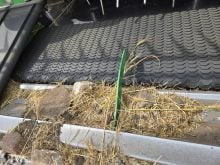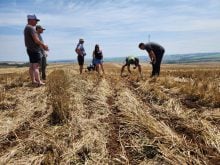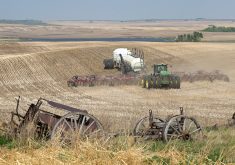Lorne Loeppky doesn’t like to be on the phone when he is busy managing his 3,500 acres of crop, delivering grain or overseeing his hog barns.
But until a few years ago that was the typical farmer’s plight: at the busiest times of the year things can go wrong and producers have to shut down to find something, do market research or make sales.
Thanks to today’s technology, however, Loeppky is able to focus on crop production during good weather and hog production during the work day and leave his parts-seeking, marketing and banking to more convenient times.
Read Also

Forecast leans toward cooling trend
July saw below average temperatures, August came in with near to slightly above average temperatures and September built on this warming trend with well above average temperatures for the month.
It’s a technological revolution that has come quickly but made his life a lot better.
“The internet has sure shrunk the world,” said Loeppky, who farms near Niverville, Man.
“The last 10 years has been amazing.”
The number of internet tools for farmers has increased in recent years. Critical information and analytical products that once had to be bought from companies and professionals are often now available to producers for free, as long as they’re willing to find them and use them.
Much of the information and many of the free programs can be used by any farm looking for basic analysis.
For farmers wanting specialized information or abilities and a closer connection to exclusive analysis, many companies offer subscription services that go far beyond what they offer for free.
Crop production
The AgTech Nozzle Selector database gives producers a chance to review and select their sprayer nozzles based on more than a decade of research by that Alberta Agriculture institute.
The AgTech Centre in Lethbridge populated its database with data, photographs and video of nearly every nozzle available to Canadian farmers, and even some more exotic offerings. It is still being refined, but test drives are available at 70.65.224.144/spraydata/.
Released in May 2009, the nitrogen rate calculator for wheat, barley and canola from Manitoba Agriculture and Viterra provides financial production advice related to the most expensive nutrient investment that most farmers make each year.
The tool’s estimates balance yield increase against expected yield gain on a per acre basis. The calculator is formed around real world experiments in a variety of soil types found across the Prairies, in this case eastern Saskatchewan and Manitoba. The data plots the profitability curves surrounding risk and investment in plant nutrition. It’s at www.gov.mb.ca/agriculture/financial/farm/nitrogencalc.html.
Livestock production
Loeppky and his neighbours do their statistical management on-line.
Each hog producer gathers daily data and e-mails it to a woman who compiles and uploads it to a management site. Rather than spending time doing data management, Loeppky can focus on analyzing how his farm is doing compared to the others.
“Instead of my guys trying to do it or having to have another guy on staff, we just e-mail what happened in the barn that day and she puts it in the computer and in the right place,” Loeppky said.
Markets
Market information is one of the goldmines of the internet for farmers.
Internet access offers a lot of filter-free information and most futures exchanges offer free access to prices, charts and basic analysis. This allows farmers to quickly find commodity prices and basic commentary.
Check out www.mgex.com for hard red spring wheat, www.cmegroup.com for oats, corn and soybeans and www.kcbt.com for hard red winter wheat. The former Winnipeg Commodity Exchange, now called ICE Futures Canada, offers commodity prices and basic charts at www.theice.com.
The Canadian Wheat Board’s site offers detailed information on its programs and price predictions at www.cwb.ca.
For farmers who want to chart commodity markets more intensively, sites such as www.barchart.com offer free information and charts. For a subscription of about $22 a month, these sites offer an ocean of additional information and commentary.
Companies such as Barchart, the Chicago Mercantile Exchange and The Western Producer also offer daily e-mails of market commentary, which means producers don’t need to go looking for the information – it will be on their cellphone.
Analytical firms such as Allendale Inc. at www.allendale-inc.com offer in-depth analysis for free and for a subscription fee for those looking for more technical analysis.
Loeppky said he saves time when marketing by checking out grain companies’ crop bids on their websites. Most now offer live prices so it’s easy to see the market.
“It saves me making many phone calls,” he said.
“I can see who’s got the highest prices today and make one phone call (to arrange the delivery) instead of six phone calls.”
Purchasing
Loeppky said he avoids downtime by searching for parts at night when he isn’t farming.
Until recently, farmers needing parts would have to call dealers during business hours. Often that meant waiting 12 or 14 hours before finding out whether a dealer had a part or if he would have to travel further to buy it.
Now, most dealers are on-line and their inventory is easily searchable. If a piece is in, a producer can find it, buy it, show up the next morning and get back to farming.
“I pick it up and I’m gone,” Loeppky said.
Dealer sites also offer a chance to check competitive prices.
“It’s a real bargaining tool,” said Loeppky.
Some dealers will match competitors’ posted prices, he added.
Banking
Banks and credit unions encourage on-line banking because it saves them money and allows them to have fewer staff. But many farmers are embracing it because it allows them to stay on the farm and avoid those time-consuming trips to town to visit the local branch to do basic banking.
“We do 99 percent on-line,” Loeppky said.
“A lot of times there just isn’t time to run into town and to the branch. You can do this at 10 o’clock at night or at three in the afternoon. It doesn’t matter.”
Mortgage and loan shopping can also be done on-line, offering producers a quick way to check competitive rates in a wide area.
Tools
As the internet grows and becomes more complex, ways of accessing it have become simpler.
Instead of being forced to buy ever larger, more complicated and more expensive computers, many farmers find that affordable, off-the-shelf desktop or laptop computers can do everything they need.
But the most significant development of the past decade has been electronic portability.
The need for a computer to do basic internet business has faded as handheld devices take over much of the role. Most handhelds can be used to surf the internet and send e-mail.
Smart phones have become the tool of choice for e-mail addicted businesspeople, but Loeppky said cellphones often offer all he needs, and he doesn’t need to use his own.
“Usually, when I want something, it’s when I’m driving, so I get the next generation to look for me,” Loeppky said with a laugh.
He especially relies on his 14-year-old daughter to search out prices and other information, not only because he doesn’t want to pull over to do it himself but also because she’s “about 10 times as fast as me.”
At home on his office computer, he also relies on his children to boost his normally slow internet progress.
“They’ll walk by me, see what I’m doing, and say, ‘dad, just click here,’” Loeppky said.
“They’ll zip here, zip there, click here, click there and we’re done.”















